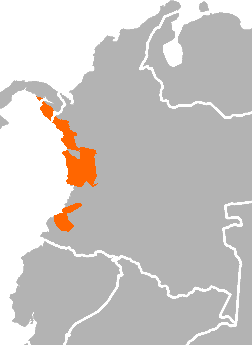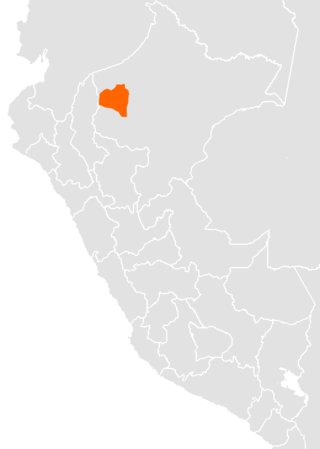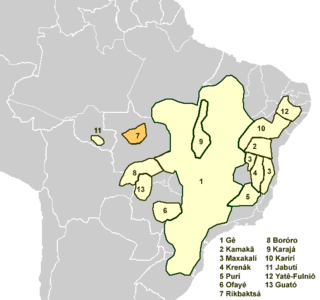Related Research Articles

The Choco languages are a small family of Native American languages spread across Colombia and Panama.
The Waorani (Huaorani) language, commonly known as Sabela is a vulnerable language isolate spoken by the Huaorani people, an indigenous group living in the Amazon rainforest between the Napo and Curaray Rivers in Ecuador. A small number of speakers with so-called uncontacted groups may live in Peru.
Yuracaré is an endangered language isolate of central Bolivia in Cochabamba and Beni departments spoken by the Yuracaré people.
Itonama is a moribund or extinct language isolate once spoken by the Itonama people in the Amazonian lowlands of north-eastern Bolivia. It was spoken on the Itonomas River and Lake in Beni Department.

Kamëntsá, also referred to as Camsá, Mocoa, Sibundoy, Coche, or Kamemtxa / Camëntsëá, is a language isolate and native language of the Camsá people who primarily inhabit the Sibundoy Valley of the Putumayo Department in the south of Colombia.

Candoshi-Shapra is an indigenous American language isolate, spoken by several thousand people in western South America along the Chapuli, Huitoyacu, Pastaza, and Morona river valleys. There are two dialects, Chapara and Kandoashi. It is an official language of Peru, like other native languages in the areas in which they are spoken and are the predominant language in use. Around 88.5 percent of the speakers are bilingual with Spanish. The literacy rate in Candoshi-Shapra is 10 to 30 percent and 15 to 25 percent in the second language Spanish. There is a Candoshi-Shapra dictionary, and grammar rules have been codified.
Arutani is a nearly extinct language spoken in Roraima, Brazil and in the Karum River area of Bolivar State, Venezuela. There are only around 6 speakers left.
Omurano is an unclassified language from Peru. It is also known as Humurana, Roamaina, Numurana, Umurano, and Mayna. The language was presumed to have become extinct by 1958, but in 2011 a rememberer was found who knew some 20 words in Omurano; he claimed that there were still people who could speak it.

The Rikbaktsa language, also spelled Aripaktsa, Erikbatsa, Erikpatsa and known ambiguously as Canoeiro, is a language spoken by the Rikbaktsa people of Mato Grosso, Brazil, that forms its own branch of the Macro-Gê languages.
Andaqui is an extinct language from the southern highlands of Colombia. It has been linked to the Paezan or Barbacoan languages, but no connections have been demonstrated. It was spoken by the Andaqui people of Colombia.
Irántxe /iˈɻɑːntʃeɪ/, also known as Mỹky (Münkü) or still as Irántxe-Münkü, is an indigenous language spoken by the Irántxe and Mỹky peoples in the state of Mato Grosso in Brazil. Recent descriptions of the language analyze it as a language isolate, in that it "bears no similarity with other language families". Monserrat (2010) is a well-reviewed grammar of the language.
Aikanã is an endangered language isolate spoken by about 200 Aikanã people in Rondônia, Brazil. It is morphologically complex and has SOV word order. Aikanã uses the Latin script. The people live with speakers of Koaia (Kwaza).

Harakmbut or Harakmbet is the native language of the Harakmbut people of Peru. It is spoken along the Madre de Dios and Colorado Rivers, in the pre-contact country of the people. There are two dialects that remain vital: Amarakaeri (Arakmbut) and Watipaeri (Huachipaeri), which are reported to be mutually intelligible. The relationship between speakers of the two dialects is hostile.

Guató is a possible language isolate spoken by 1% of the Guató people of Brazil.

The Ofayé or Opaye language, also Ofaié-Xavante, Opaié-Shavante, forms its own branch of the Macro-Jê languages. It is spoken by only a couple of the small Ofayé people, though language revitalization efforts are underway. Grammatical descriptions have been made by the Pankararú linguist Maria das Dores de Oliveira (Pankararu), as well as by Sarah C. Gudschinsky and Jennifer E. da Silva, from the Universidade Federal do Mato Grosso do Sul.
The Yaruro language is an indigenous language spoken by Yaruro people, along the Orinoco, Cinaruco, Meta, and Apure rivers of Venezuela. It is not well classified; it may be an isolate, or distantly related to the extinct Esmeralda language.
Taushiro, also known as Pinche or Pinchi, is a nearly extinct possible language isolate of the Peruvian Amazon near Ecuador. In 2000 SIL counted one speaker in an ethnic population of 20. Documentation was done in the mid-1970s by Neftalí Alicea. The last living speaker of Taushiro, Amadeo García García, was profiled in The New York Times in 2017.
Chimané (Tsimané) is a South American language isolate. Some dialects are known as Mosetén. Chimane is a language of the western Bolivian lowlands spoken by the Tsimane peoples along the Beni River and the region around San Borja in the Department of Beni (Bolivia). Sakel (2004) classifies them as two languages for a number of reasons, yet some of the variants of the language are mutually intelligible and they reportedly have no trouble communicating and were evidently a single language separated recently through cultural contact.
Lapachu, also known as Apolista or Aguachile, is an extinct Arawakan language of Bolivia. Aikhenvald (1999) classifies it together with Terena, Moxos, and related languages. It is not clear from surviving descriptions whether it was one language or two.
Harákmbut–Katukinan is a proposal linking the South American indigenous language families Harákmbut and Katukinan. There is reasonably good evidence that the two are related. Jolkesky (2011) also adds Arawan to the family.
References
- ↑ Anserma at Ethnologue (25th ed., 2022)

Caramanta at Ethnologue (25th ed., 2022)
- ↑ Campbell, Lyle, and Verónica Grondona (eds). 2012. The indigenous languages of South America: a comprehensive guide. Berlin: De Gruyter Mouton.
- ↑ Jolkesky, Marcelo Pinho de Valhery (2016). Estudo arqueo-ecolinguístico das terras tropicais sul-americanas (Ph.D. dissertation) (2 ed.). Brasília: University of Brasília.